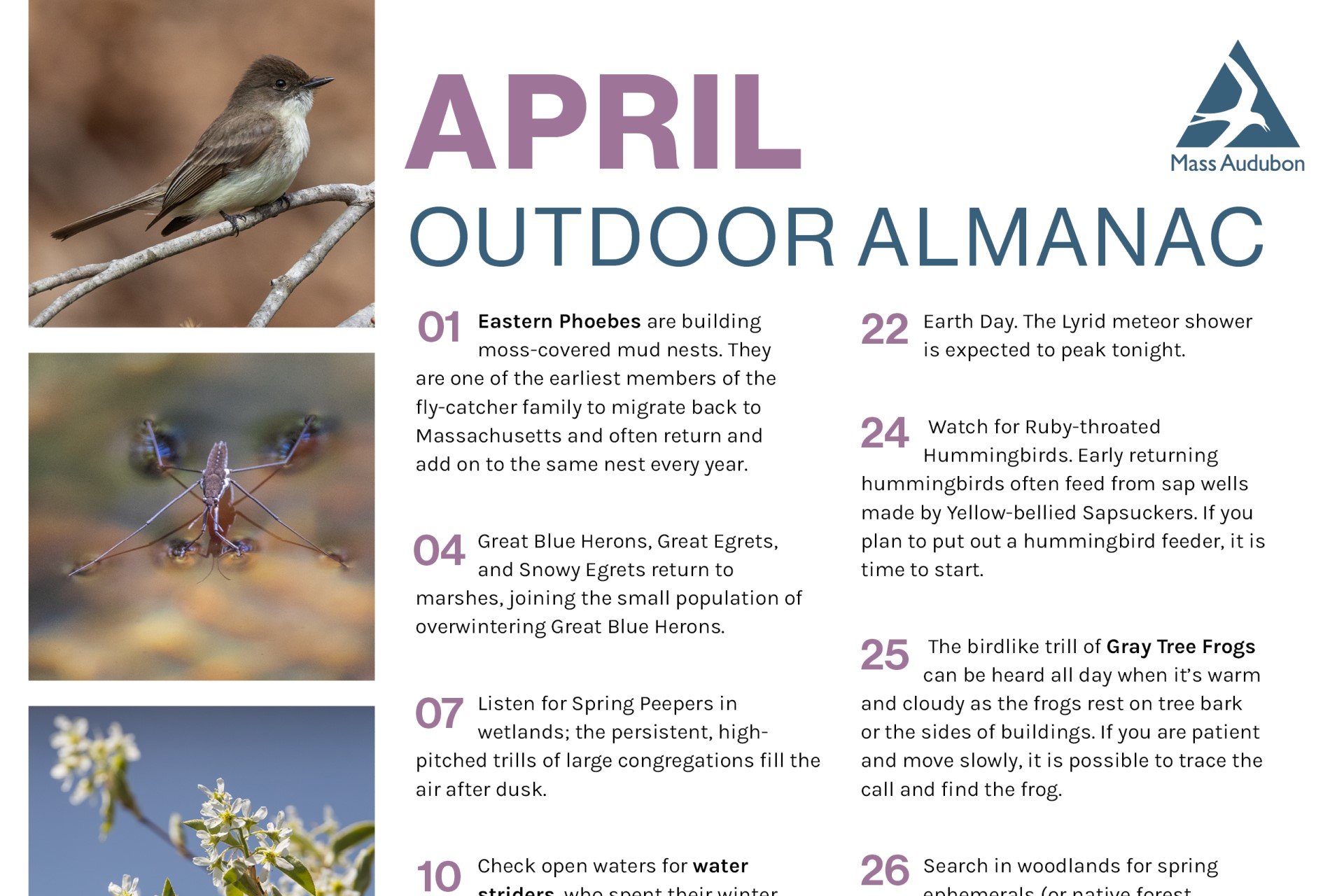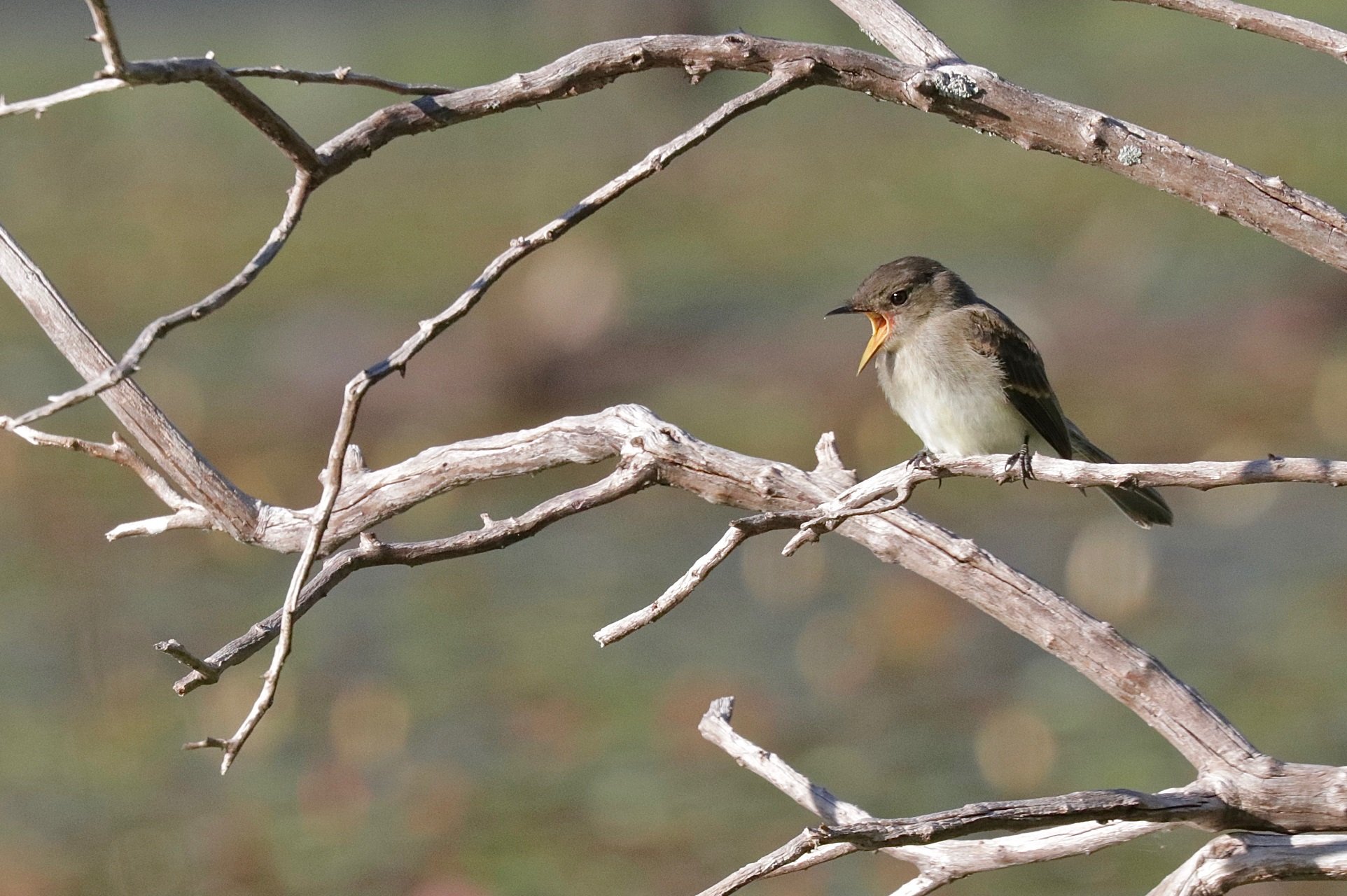Outdoor Almanac
April is a month of renewal, enlivened by the bursting of life across Massachusetts. Eastern Phoebes are busy rebuilding their mossy nests, while egrets return to the marshes. Listen for choruses of Spring Peepers filling the evening air and keep an eye out for Ruby-throated Hummingbirds arriving to sip from early blooms. Earth Day brings a celestial treat with the peak of the Lyrid meteor shower, and delicate spring wildflowers like Trillium and Bloodroot begin to carpet the forest floor.
What will you discover this April? Visit a nearby wildlife sanctuary or join us for a program to make the most of your month.

Outdoor Almanac
Download or print this month's outdoor almanac.
APRIL
1
Eastern Phoebes are building moss-covered mud nests. They are one of the earliest members of the fly-catcher family to migrate back to Massachusetts and often return and add on to the same nest every year.
4
Great Blue Herons, Great Egrets, and Snowy Egrets return to marshes, joining the small population of overwintering Great Blue Herons.
7
Listen for Spring Peepers in wetlands; the persistent, high-pitched trills of large congregations fill the air after dusk.
10
Check open waters for water striders, who spent their winter hidden under leaf litter on the shore. These insects have water-repellent hairs that allow them to sit atop the water, not disturbing the surface tension as they glide to look for prey.
12
It’s breeding season for Eastern Musk Turtles, also known as “stinkpots.” This elusive reptile is nocturnal but can sometimes be seen basking in the sun on logs and vegetation in still waters.
13
Full moon.
14
Eastern shadbush, also called serviceberry, blooms in wetlands and moist woodlands, creating clouds of white blossoms along riverbanks.
19
Red Squirrels have shed their warm, deep-red winter fur. They are more olive green-to-brown during the warmer seasons.
22
Earth Day. The Lyrid meteor shower is expected to peak tonight.
24
Watch for Ruby-throated Hummingbirds. Early returning hummingbirds often feed from sap wells made by Yellow-bellied Sapsuckers. If you plan to put out a hummingbird feeder, it is time to start.
25
The birdlike trill of Gray Tree Frogs can be heard all day when it’s warm and cloudy as the frogs rest on tree bark or the sides of buildings. If you are patient and move slowly, it is possible to trace the call and find the frog.
26
Search in woodlands for spring ephemerals (or native forest perennials that bloom before the leaves come out), such as Trout Lily, Trillium, Bloodroot, Trailing Arbutus, and Hepatica.
27
Ferns emerge from the ground tightly wound like the scroll on the end of a fiddle, earning them the nickname, “fiddleheads.”
30
Killdeer start breeding and laying eggs in April. These birds perform an iconic distraction display to divert the attention of predators away from their nest by feigning injury by drooping a wing and fanning their tail.
Upcoming Programs this Month
See MoreSpring Into Nature April Vacation Week
-
5 classes starting
Monday, April 21
10:00am-2:00pm
Age 5 - 10
Tuesday Birdwatching Meander
-
Tuesday, April 22
8:00-10:00am
Adults
Tuesday Morning Bird Walk
-
Fowl Meadow, Burma Trail, Milton
-
Tuesday, April 22
8:00-9:30am
Adults
April Vacation Adventure Days: Ages 7 & 8
-
Ipswich River Wildlife Sanctuary, Topsfield
-
4 classes starting
Tuesday, April 22
8:30am-3:00pm
Age 5 - 11
Wild at Art: April Vacation Camp
-
Museum of American Bird Art Education Center, Canton
-
Tuesday, April 22 - Friday, April 25
9:00am-3:00pm
Age 7 - 10
Spring Naturalist Walk
-
Broadmoor Wildlife Sanctuary, Natick
-
Tuesday, April 22
10:00am-12:00pm
Adults
Stay Connected
Don't miss a beat on all the ways you can get outdoors, celebrate nature, and get involved.



